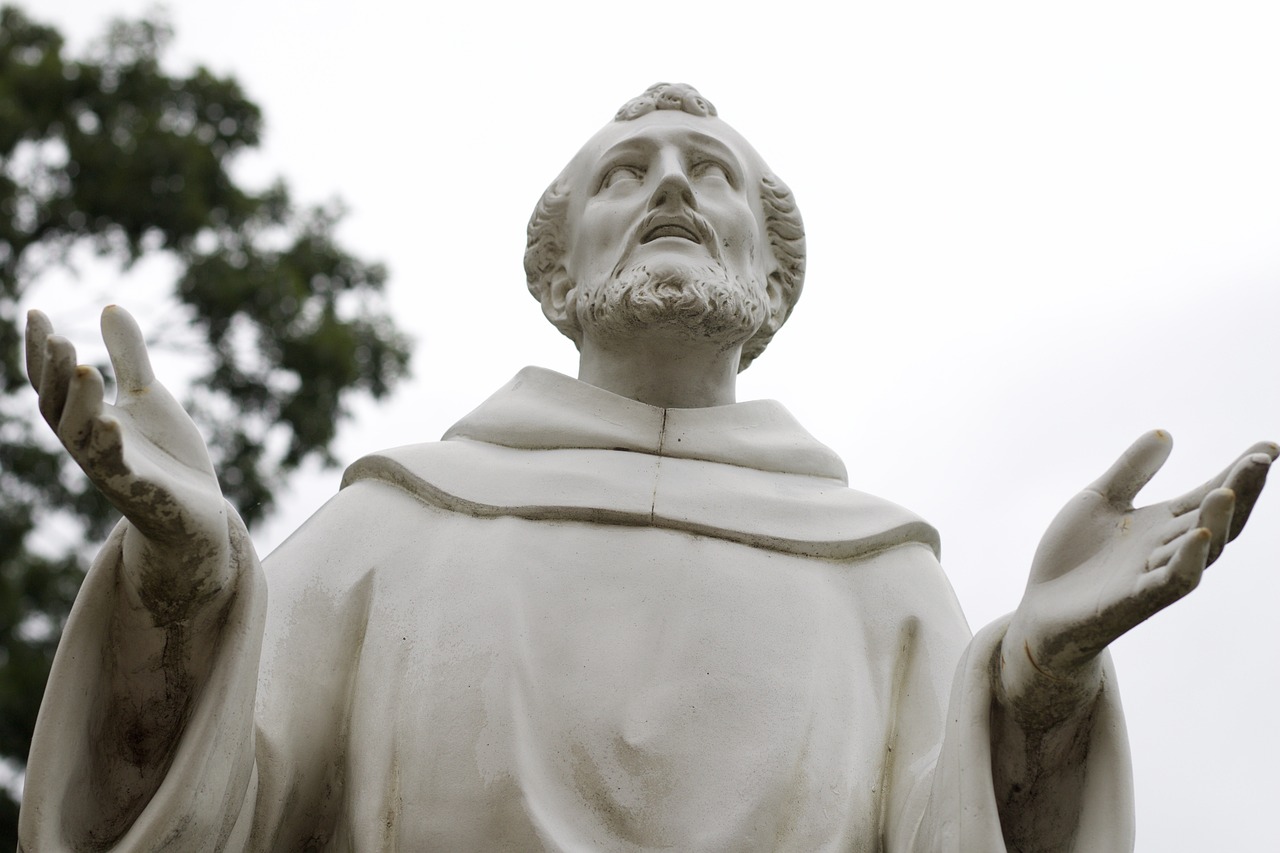St. Francis of Assisi, born Giovanni di Pietro di Bernardone (1181 – 1286), is one of the most influential figures in the history of the Christian faith. His life exemplified an unwavering submission to his Purpose, inspiring people with humility, compassion, and, most importantly, love for all God’s creations. The collective effort of the Franciscans, inspired by his founding work, has positively impacted millions of poor, outcast, and socially marginalized people. Today, nearly 800 years after his death, approximately 11,000 Franciscan Friars worldwide continue to take vows of poverty and obedience to espouse charity, benevolence, and selflessness for the benefit of others.
We’ve chosen to highlight St. Francis of Assisi for how his Purpose of loving all of God’s creation transcended every aspect of his life and for the hope to be gained in examining his less-than-direct path toward finding his Purpose. But first, a quick reminder of our definition of Purpose and how it fits within the Antifragile framework.
The AQ Element of Purpose is about finding a fixed point of orientation to guide our lives and aligning all our actions to that highest aim. It is the second of the three Foundational Elements of Antifragility. It’s inextricably tied to and supported by the first of the three Foundational Elements of Antifragility, the AQ Element of Clarity. Together, Clarity and Purpose support us in experiencing the third Foundational Element of Antifragility, Connection, which we’ll write about later. Living and leading in Antifragility is impossible without experiencing the three Elements together, with Purpose providing the “why” behind it all. So how did St. Francis of Assisi come to embody living out his Purpose?
He Learned to Understand His Wiring
The St. Francis history remembers in part for his voluntary life of poverty is unrecognizable from the young Giovanni di Pietro di Bernardone. Giovanni was attractive as a young man, the son of a wealthy Italian silk merchant and French noblewoman. He was known for dressing stylishly and spending money carelessly. He ran in rich circles and pursued life’s pleasures in earnest.
It was an experience young Giovanni had while working for his father in the marketplace that first opened his eyes to the poverty and pain around him. Giovanni was approached by a beggar while conducting business and left his shop behind to chase the man down after finishing a sale. The man’s condition so moved Giovanni that he gave the man all his money. Giovanni’s friends didn’t support the decision, and his father was furious, punishing him severely. While the encounter stayed with Giovanni, he lived relatively unaffected for some time.
Shortly after the turn of the 13th century, Giovanni joined a military expedition against a rival province and was taken prisoner. While spending a year in captivity, he fell ill and was said to have spent the time reflecting on his life. Even at this, Giovanni returned to his previous life after being released and voluntarily joined another military campaign in pursuit of glory in 1203.
It wasn’t until 1205 that Giovanni became thoroughly disillusioned with his old ways and began pursuing his Purpose, spending time among the poor and reflecting in solitude. Believing he’d been called to restore the countryside chapel of San Damiano in Assisi that had fallen into disrepair, he took the misguided path of stealing from his father to pay for the work. The priests refused the stolen money, and his father beat him and locked him in a storeroom.
After being set free by his mother, Giovanni ultimately rejected any claim to his father’s wealth and left to wander the hills of Assisi. He begged for money and used the funds he received to rebuild the chapel of San Damiano. In the following two years, he rebuilt several abandoned churches, using the space to care for lepers whom few would go near. It wasn’t until 1208 that Giovanni ultimately devoted himself to a lifetime of poverty and preaching a message of contrition, brotherly love, and peace.
It’s tempting to look at leaders of Purpose like St. Francis, who had an outsized impact on the world, and say, “Of course, they could do that, but I’m not like them.” However, when we step back and reflect upon the whole story and not just look at the outcomes, we see there is more to learn. We see that ordinary people like you, me, and Giovanni di Pietro di Bernardone can do extraordinary things when we submit to a transcendent Purpose. It’s worth noting that St. Francis himself said, “If God can work through me, he can work through anyone.” It’s also worth noting that it wasn’t until he learned his Purpose that his positive impact on those around him began to accelerate.
He Aligned His Contributions to His Purpose
By 1209 Giovanni had a small following of like-minded devotees and wrote the Regula primitiva or “Primitive Rule” to guide him and his followers. Shortly after, he led his small following of 11 to Rome in hopes of gaining an audience with Pope Innocent III. Their goal was to establish a religious order based on their principles.
Upon arrival in Rome, Giovanni was fortunate to connect with the Cardinal Bishop of Sabina, who had close personal ties to Pope Innocent III. The Cardinal Bishop Sabina looked fondly at Giovanni and his followers. He eventually secured an informal meeting with the Pope, who was warm to the idea but not entirely convinced. Pope Innocent III agreed to their formation informally and recommended they return when their group had grown in number and impact. Not to be dissuaded, In April of 1210, a matter of months later, the Franciscan Order was officially established. It was at this point that the Franciscans began to grow rapidly.
By 1212 the Franciscan Order had birthed two additional Orders, one for women and another for non-clergy who couldn’t leave their lives behind but lived out the Franciscan principles in their normal day-to-day living. The Franciscans had grown beyond the borders of Italy, and St. Francis was traveling the world, spreading the message of sacrifice and love for all God’s creation.
In aligning his contributions to his Purpose in writing the Regula primitiva, we see that St. Francis galvanized his small following. And it was his drive to formalize the Franciscan Order that propelled his mission and vision worldwide. These are great reminders for all of us regarding the importance of clearly defining our Purpose to guide us and inform others.
He Identified and Continually Revisited His Highest Aim
There is no questioning that St. Francis’s Purpose was the ultimate authority of his life. His love for all of God’s creation wasn’t limited to those the rest of the world held close or saw as friends. His Purpose extended to those that society had rejected and marginalized. He sought out the company of lepers, embracing them with compassion and care. His acts of love towards the outcasts challenged societal norms and reminded people of the inherent worth and dignity of every human being.
His Purpose even extended to those others saw as enemies. In 1219, during the Fifth Crusade, St Francis traveled to Egypt. While the bloody battle would ultimately see Sultan al-Kamil of Egypt and his forces repel the invaders, St. Francis used the opportunity to live out his Purpose. During a ceasefire, he and an advisor crossed the battle lines to seek an audience with the Sultan.
While there are no official writings about what transpired in the days St. Francis spent with Sultan al-Kamil and his forces, the Sultan was so taken with him that he granted St. Francis special permission to visit the sacred sites in Jerusalem. He was also allowed to openly preach his message of love for all of God’s creation while he was there. It’s because of St. Francis’s Purposeful message and the generous receptivity of the Sultan that the Franciscans have been allowed to operate in Jerusalem since 1217, even during the many conflicts that have transpired throughout history.
St. Francis’s love for all of God’s creation extended beyond people to encompass the natural world as well. He saw himself as a steward of creation long before it became commonplace, emphasizing the interconnectedness of all life. He called all creatures “brothers” and “sisters” and famously preached to birds. A song he composed thanked God for the sun, moon, earth, wind, water, and fire, which he saw as “brothers’ and “sisters” as well.
St. Francis of Assisi’s life is a powerful reminder of what is possible when we live out the AQ Element of Purpose. It shows us what is possible when we turn from being our own masters or allowing ourselves to be mastered by what makes us comfortable, choosing instead to submit to a transcendent Purpose. His leadership also illustrates people’s inner hunger to align behind a transcendent Purpose, working in Connection to bring about positive change. He and his followers are a model to us all of what it means to live and lead in Antifragility!
Take Your Assessment now
take the complimentary
aq assessment
move forward
COMPLIMENTARY REVIEW OF EXPANDED AQ ASSESSMENT RESULTS
- 30-MINUTE REVIEW WITH A CERTIFIED AQ GUIDE
- LEARN WHERE YOUR GROWTH OPPORTUNITIES LIE
- COMPLiMENTARY FOR QUALIFIED LEADERS





